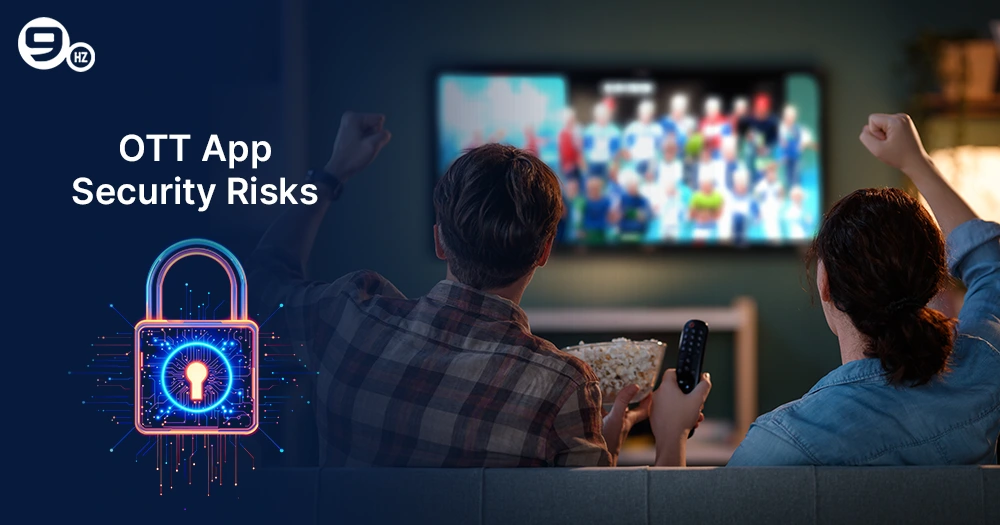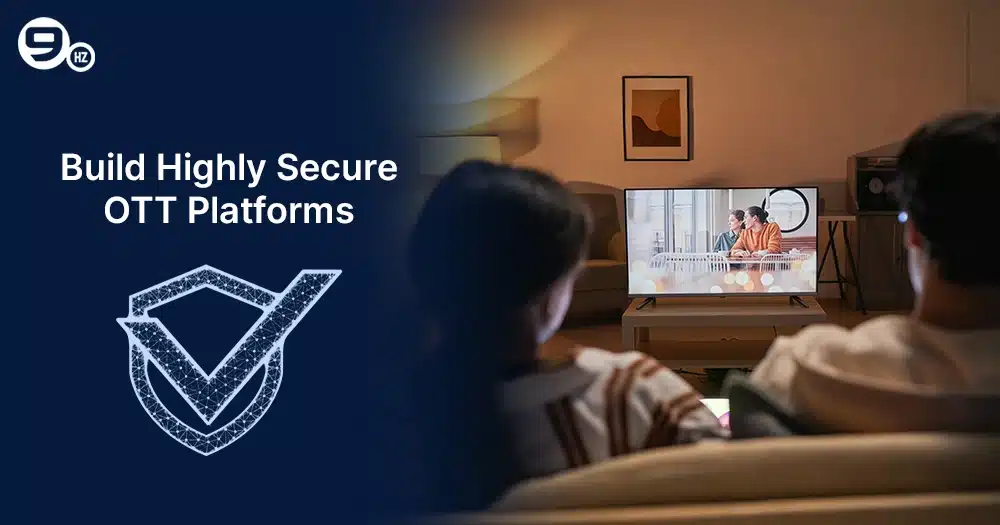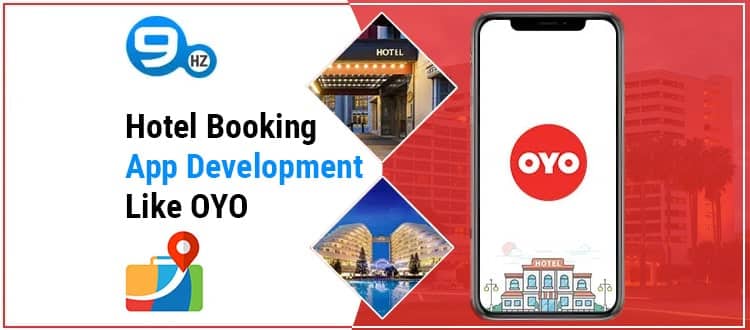According to Statista, the OTT video market worldwide is expected to reach a revenue of $343.82 billion by the end of 2025. The revenue is further expected to show a CAGR of 6.31% to achieve the milestone of $466.82 billion by 2030. At the same time, OTT platforms are anticipated to attract 473.4 million users by 2030.
OTT platforms are burgeoning like no other industry, with thousands and millions of users registering every day to browse fresh content. However, OTT app security risks have made it highly concerning both for users as well as the app owners to protect their information.
For instance, Netflix has over 300 million active users around the world, which makes it an ideal platform for hackers to steal a huge amount of data like names, contact information, demographics, and much more. Other types of security risks include pirating content, password borrowing, and subscription sharing that affect the financial gains of the platform in the long run.
So, this blog will be talking about the multiple OTT app security risks & solutions that you must know if you are planning to enter the business by building an OTT app. You might be interested to about top OTT app development companies.
10 Most Prominent OTT App Security Risks With Associated Solutions
It is surprising to witness that most of the OTT app security risks and breaches are not supported by any unique or rare technical malpractices but are very common security threats that could be mitigated with little effort. However, the core focus of OTT platforms on scaling their business leaves little to no time for their team to look into these issues, which have the potential to indirectly impact the long-term growth of the platform.
Here are the main OTT app risks that have been impacting the OTT platform, along with the solutions that are used to mitigate the risks-
1. Insecure APIs
The very first OTT app security risk is insecure APIs. Most of the functions that are designed to enhance the user experience on a media app or platform are integrated with the help of some APIs. Whether it is payment processing, service recommendation, or logging into the account using the right credentials, APIs play a vital role in executing these tasks. However, it is important to securely configure the APIs to block the direct pathways for cyber attackers to either hijack the accounts or breach the user information.
It has been reported that many popular OTT platforms have not implemented any configuration in their APIs that offers open access to all the information related to the user profile. While the changes were implemented before any cyber attack could happen, it is still surprising to see the basic, flawed endpoints that put the information of millions at risk.
Solution
APIs can be secured using robust authentication (OAuth 2.0), rate limiting, and consistent monitoring using open-source API management platforms. At the same time, ensuring the regular security audits along wth the fuzz testing are also the good OTT app security solutions.
2. Content Piracy
Content piracy can be referred to as the biggest concern associated with OTT app security risks. Content piracy refers to the malpractices that make the paid content (movies, podcasts, series, etc.) free to watch via unofficial channels and websites. Therefore, it becomes highly challenging for the OTT platforms to get the return on the investment that they have made to bring the exclusive content to their OTT server.
The content piracy practices are mainly executed using different techniques like token theft, playback URL sharing, and sometimes taking advantage of weak DRM (Digital Rights Management). According to statistics, pirated video material receives more than 230 billion views around the world every single year.
Solution
Ensuring the time-limited tokens on the basis of authentication of streams, considering forensic watermarkeing to trace leaks, and implementing the multi-DRM protection are some of the best OTT app security solutions that can be used.
3. Poor Session Management
Session management is generally responsible for delivering a seamless user experience across the OTT platform. However, it is important to handle the sessions carefully, else they make the software prone to credential stuffing and cyber attacks. For instance, many OTT platform offers extended login sessions to their users so that they don’t have to feed credentials multiple times. However, when these extended sessions are not monitored and managed, it leaves the gates open for unauthorized access and causes serious OTT app risks.
Solutions
Extended sessions can be managed easily by implementing secure and short-lived session tokens with auto-expiry features, password changes, and re-authentication. At the same time, ensuring the device fingerprints and fraud detection system play a significant role in implementing the best security practices.
Read Also: OTT App Development Cost & Video Streaming App Development Cost
4. Random Credential Stuffing
One of the most common practices used by hackers and cyber attackers is using leaked usernames and passwords from unrelated breaches in large volumes, which helps to offer unauthorized access. The same credentials are recycled by many users across platforms, which makes it even easier for the attackers to gain access with the least effort.
For example, Netflix users across the globe reported suspicious activities in their accounts in 2023. When investigated, it was identified as an automated credential stuffing campaign that used botnets. The attackers, when they manage to break into the user’s account, can consume the content without paying anything, change the account settings, reset the credentials, sell access on the dark web, and even use the platform for testing stolen logins.
Solution
Some of the most efficient OTT app security solutions that can help prevent credential stuffing are active monitoring of login attempts performed in abnormal patterns, multi-factor authentication, bot detection system integration, and much more. At the same time, users can ensure that they use strong and unique passwords to minimize the chances of hacking.
5. Unverified Third-Party Integration
OTT platforms require different functionalities, many of which can not be developed from scratch and thus require third-party integration. It includes analytics SDKs, payment gateway, ad servers, recommendation engine, and much more. There is no doubt that third-party integration enhances the solution functionalities, but it also opens the gate to different OTT app risks that can be out of control for the internal security team.
A similar instance was recorded in 2021 when a third-party OTT analytics SDK, which was used by many OTT apps, led to the leakage of IP addresses, session behavior, and user data. There are many other consequences like data compliance violations, compromised app performance, and broken user interest that are led by unverified third-party integration.
Solution
Make sure that all the third-party vendors comply with security practices, use a zero-trust approach to integration, and review all the permissions given to the SDK carefully. At the same time, conducting regular audits for code and performing sandbox testing for external components can also help in spotting the red flags.
6. Inefficient Data Transmission
The OTT platforms consist of a lot of data about users, which includes names, contact information, addresses, payment details, preferences, and much more. When this data is transmitted into the system, it is important to ensure complete encryption, or it leads to huge risks of man-in-the-middle attacks. Most of the OTT platforms don’t even enforce HTTPS consistently, or many of those still depend on the inefficient TLS protocols, which acts like a big gap in the system.
Solution
HTTPS must be enforced across all endpoints while using the best TLS versions, implementing HSTS headers, and disabling the legacy protocols. At the same time, it is also important to perform regular vulnerability scans along with the penetration testing that help to identify the vulnerable points and make the required improvements.
Read Also:
How to Build An App Like Hulu?
Role of AI in OTT
7. Absence of Reverse Engineering Protection
OTT platforms have also been the target for reverse engineering cases where the attackers decompile the app binaries to expose proprietary algorithms, API keys, and DRM logic. Many times, the attackers even inject the malicious code into the new version of software, then distribute it through unofficial mediums, and offer ad-free and premium content for free or at lower prices.
The same case has been witnessed with a well-known app where the Android version clone was prepared by the attackers, and it succeeded in affecting thousands of devices via third-party stores. Also, the trust of users on the original platform was highly affected in the case.
Solution
Obfuscation of the code is the first requirement before deploying the platform using DexGuard or ProGuard. Moreover, the runtime protection, like anti-bugging checks, root detection, and certificate pinning, is also an effective OTT app security solution.
8. Absence of a Monitoring and Logging System
OTT platforms require robust monitoring and logging systems that can actively track OTT security risks and alert the administration as soon as any malicious activity is detected. Thus, it plays a significant role in preventing account takeovers, abuse of services, and fraudulent behavior. However, the absence of these logging systems often provides space for malicious activities to enter and grow in the system, leading to major OTT platform risks.
At the same time, the media platforms that don’t integrate a good monitoring and logging system might also face legal complexities if any incident related to security issues takes place.
Solution
It is advisable to implement the best OTT security solutions around the logging system so that it can push the real-time alerts as soon as any malicious activity is recorded. Also, it is important to ensure that logs are securely stored and immutable so that they can execute the post-incident investigation.
9. Weak User Authentication
Weak user authentication is one of the biggest contributing factors to OTT app security risks and breaches. Using simple and reused passwords, the absence of multi-factor authentication, and inefficient role-based access control directly lead to fake account access, platform abuse, and data breaches.
Such kind of breaches not only strike the user’s trust in the platform but also bring legal consequences to the OTT firms for compromising with data protection laws like CCPA and GDPR.
Solution
The foremost solution is enforcing strong password policies, which ensure that users build a lengthy and strong password. At the same time, implementing multi-factor authentication is also a good approach to strengthening user authentication. Moreover, robust RBAC is also ensured to limit access to sensitive information related to users. Another common practice is regular audit authentication for better risk management.
10. Inefficient Data Storage Practices
There is a big chance of a data breach when the storage of confidential information like usernames, passwords, payment methods, etc., is not stored efficiently. For instance, a live streaming platform in 2020 exposed 10.8 billion records in an unsecured ElasticSearch database. Anyone who knew the location of this database could easily access all the available information, including the demographics, email addresses, payment logs, chat transcripts, and much more.
Such instances lead to direct violation of data protection laws like CCPA and GDPR. At the same time, incidents like these, where OTT companies compromise with data security, often impact the user’s confidence in the platform.
Solution
For secure and efficient data storage, platforms should ensure that all the information is encrypted during transit as well as at rest. Strict data retention policy implementation is also a good approach that ensures data anonymization. Another common practice is regular system audits to identify vulnerabilities as well as ensure legal compliance.
How Can The NineHertz Help You Build Highly Secure OTT Platforms?
The security standards and quality of an OTT platform are highly influenced by the development company you are partnered with. Hiring an experienced OTT development company not only saves you a lot of miscellaneous costs but also ensures the strong security practices that bring users’ trust into the platform.
The NineHertz is a leading OTT development company with experience of more than a decade in building high-performing digital applications and software. We work with a team of 250+ tech enthusiasts, dedicated to exploring and implementing novel technologies.
Our team has profound expertise in OTT security solutions, legal compliance, and techniques that mitigate the chances of hacking and breaching. At the same time, we offer continuous maintenance and support to our clients, which ensures the consistent vulnerability scans and security audits.
The NineHertz also offers free consultation that allows business to discuss their vision, project scope, and priorities. Thus, we curate a personalized roadmap to build the OTT platforms accordingly.
Conclusion on OTT App Security Risks
OTT platforms have emerged as a popular domain that can attract millions of users in no time. Just good content, basic features, and robust security for the user information are all it requires for an OTT app to be successful. However, most of the OTT solution in the market lacks data safety practices, which brings a lot of risks and breach chances. The compromise in data not only drives the financial losses to the firm but also directly impacts the trust of users on the platform.
As a leading Video Streaming app development company, The NineHertz holds profound expertise in robust security practices for media platforms. Get a free consultation with our team and kickstart your project.
FAQs on OTT App Security Solutions
1. What are the Common OTT Security Risks?
The common risks associated with the OTT platforms are unauthorized access, content piracy, vulnerable APIs, and data breaches. OTT platforms carry confidential information about the users and paid content, both of which remain the prime target of attackers during security breaches.
2. What are Some of the Practices that Can Help Prevent OTT Security Risks?
Some of the common practices that can help mitigate OTT security risks are strong authentication, encryption, access control, fraud detection, vulnerability testing, etc.
3. How Much Does it Cost to Build an OTT App?
It generally costs $40,000 to $200,000 to build an OTT app from scratch. However, the exact amount can vary on the basis of different factors like project complexity, location of development team, number and types of features, third-party integration, customization, designing, post-deployment maintenance & support, etc.
4. How Much Time Does it Take to Build an OTT App?
It takes anywhere between 4-8 months for OTT app development. The exact timeline is influenced by team size, technology stack, API integration, development approach and platform, hiring model, etc.
Great Together!





![How to Create an App like Careem? [Cost in 2025]](https://theninehertz.com/wp-content/uploads/2024/09/how-to-create-an-app-like-careem.webp)





